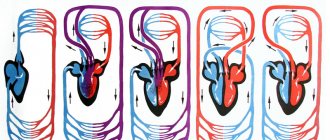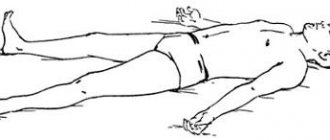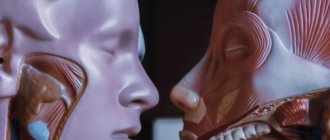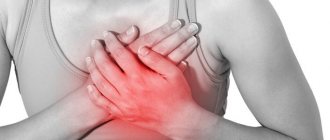What is blood pressure?
This is an indicator of the amount/force of blood pressure exerted on the walls of blood vessels. When measuring blood pressure with a tonometer, two numbers are taken into account - the lower and upper values. This is the value at the time of maximum tension of the heart muscle (systolic blood pressure or systole) and the value at the moment of its maximum relaxation (diastolic pressure or diastole).
Reference.
Blood pressure (BP) is not a constant value. Pressure readings may vary depending on a number of factors. Even in the same patient, blood pressure fluctuations are observed throughout the day. For example, in the morning after waking up, blood pressure may be low, but in the afternoon it may begin to rise.
Children have lower blood pressure than adults. The risk of developing arterial hypertension increases with age.
The table shows blood pressure standards (by age)
ARTERIAL PRESSURE
BLOOD PRESSURE, blood pressure in the arteries. Blood pressure level is expressed in millimeters of mercury (mm Hg) and depends on the pumping force of the heart, peripheral. vascular resistance and circulating blood volume. Systolic pressure reflects max. blood pressure on the walls of the arteries during contraction of the heart, diastolic - at the moment of its relaxation and depends mainly. from peripheral vascular resistance. In humans, for example, the systolic ratio and diastolic pressure is normally 120/80, in a giraffe 340/230, in a dog 156/100, in a shark 32/16 mm Hg. Art. There are also pulse pressure (the difference between systolic and diastolic), depending on the volume of blood ejected with each contraction of the heart and the elastic properties of the aorta, and average blood pressure (equal to the sum of diastolic and 1/3 pulse pressure), proportional to the volume of blood, ejected by the heart in 1 minute, and general peripheral. resistance of the blood vessel system. In most mammals (including humans) it is 100 mm Hg. Art. Blood pressure values decrease as the vessel moves away from the heart. For example, in a healthy adult, systolic. the pressure in the aorta is 110–130 mm Hg. Art., in arterioles – 20–50 mm Hg. Art. During the day it fluctuates depending on functional activity and decreases significantly at night during sleep (70–80 mm Hg). In vessels located above the level of the heart, the pressure decreases in proportion to the size of the hydrostatic column. A giraffe, for example, needs a high blood pressure so that blood can reach the head. Max. blood pressure values in annelids and arthropods are 5–10 mm Hg. Art., for active fish (e.g. salmon, eel) – 65–75, for the green frog – approx. 40, in birds – 140–180 mm Hg. Art. Male warm-blooded animals have a higher blood pressure than females, and cold-blooded animals have a lower blood pressure than warm-blooded animals.
In vertebrates, conservation refers. The constancy of the blood pressure level is ensured by a regulatory system, due to which a certain relationship is achieved between the work of the heart, the lumen of blood vessels, the capacity of the vascular bed and the amount of circulating blood. The action is physiological. regulation mechanisms can be short-term or long-term. The former include the renin-angiotensin-aldosterone system and cardiovascular reflexes. These reflexes are mediated through the center. nervous system (the so-called baroreflex, chemoreflex, cerebroischemic reaction), maintain a normal blood pressure level from several. minutes to several minutes hours.
Baroreceptors located in the wall of the aortic arch and in the area of the branch of the common carotid artery (carotid sinus) respond to the degree of stretching of the vascular wall with an increase in blood pressure. The frequency of impulses coming from the baroreceptors to the cardiovascular center in the medulla oblongata increases, which leads to to a reflex decrease in cardiac output and peripheral resistance. vessels and, as a consequence, a decrease in blood pressure. The higher the pressure in the aortic arch and carotid sinus, the stronger the nervous influences leading to a decrease in blood pressure. When blood pressure falls, the frequency of impulses coming from the baroreceptors decreases and reflexively increases cardiac output and resistance of small arteries and arterioles and hence pressure. The baroreflex acts as a buffer, smoothing out rapid fluctuations in blood pressure, for example. with a sharp transition from a horizontal to a vertical position, no phenomena associated with impaired blood supply to the brain are felt.
The chemoreflex is triggered both from the peripheral. receptors located in the aortic and carotid reflexogenic zones, and from the center. chemoreceptors localized in the medulla oblongata. The first ones are activated first. when there is a deficiency of oxygen in the blood, the latter react to an excess of carbon dioxide in it. Activation of chemoreceptors leads to reflex activation of the sympathoadrenal system. In the end, out of cuteness. nerve endings release norepinephrine, which acts on the so-called. alpha-1 adrenergic receptors on the smooth muscles of blood vessels and causes their constriction; beta-1 adrenergic receptors mediate an increase in cardiac output. Adrenaline secreted by the adrenal glands, through the activation of beta-2 adrenergic receptors, expands the bronchi, activates glycogenolysis, which leads to an increase in blood glucose.
The cerebroischemic reaction occurs when there is a significant decrease in the blood supply to the neurons of the cardiovascular center. When means. blood loss, the average blood pressure can drop to 60–70 mm Hg. Art., which leads to a deficiency of blood supply to the cardiovascular center and direct stimulation of the sympathoadrenal system and partial normalization of blood pressure. With blood loss accompanied by a decrease in blood pressure to 40–30 mm Hg. Art., hemorrhagic shock, as a rule, becomes irreversible.
When the renin-angiotensin system is activated, the increase in blood pressure is caused by the formation of angiotensin-II (formed with the participation of renin), which causes vasoconstriction, and an increase in the secretion of aldosterone, which leads to an increase in the volume of circulating blood.
Long-term regulation of blood pressure is carried out with the participation of the kidneys, which ensure a balance between the consumption and release of sodium and water ions; even a slight increase in blood pressure is accompanied by a significant increase in fluid secretion by the kidneys. It is well-functioning kidneys that maintain the average blood pressure within the normal range throughout a person’s life.
Blood pressure is most accurately measured directly using catheters inserted into blood vessels and connected to pressure sensors. A less accurate measurement method proposed by Ros. surgeon N. S. Korotkov in the beginning. 20th century, records the value of blood pressure using a tonometer - a pressure gauge connected to a rubber cuff, fastened around the arm in humans, and around a limb or tail (in rats) in animals. The air pumped into the cuff compresses the artery and the moment when the vessel stops passing blood is determined using a phonendoscope by the cessation of pulse sound vibrations. Slowly releasing air from the cuff, the moment of the sound caused by the contraction of the heart is recorded, and the systolic value is determined using the pressure gauge. pressure. The pressure gauge readings at the moment the pulse disappears correspond to the diastolic value. pressure.
In humans, blood pressure is considered elevated, at which the values of systolic. and diastolic pressures exceed 140 and 90 mm Hg, respectively. Art. A long-term increase in human blood pressure is arterial hypertension, a decrease is arterial hypotension.
Arterial hypertension in pregnant women
According to statistics, arterial hypertension is diagnosed in 5-8% of pregnant women. There are two types of hypertension:
- chronic - the woman had the disease before pregnancy and worsened after conception;
- gestational - formed in the second half of pregnancy.
The main reasons for persistent high blood pressure in pregnant women:
- weight gain;
- acceleration of metabolic processes;
- increased intra-abdominal pressure and blood volume;
- changes in hormonal levels.
Without timely treatment, hypertension during pregnancy can lead to serious complications: gestosis (preeclampsia, eclampsia), fetoplacental insufficiency, premature birth, placental abruption and others.
If arterial hypertension is detected, a pregnant woman should be under constant medical supervision.
Hypertension and hypotension, low blood pressure, symptoms, diet, treatment
These diseases have a common pedigree and causes, a common prevention, but different consequences from the destructive action and completely opposite methods of treatment. What do you need to remember to avoid complications?
Causes of increased and decreased pressure
If the sympathetic centers of the autonomic nervous system are excited, the pressure rises, if the parasympathetic centers, the pressure drops. People in whom these departments function harmoniously have excellent health. But often the scales tip in one direction, and then a person becomes a candidate for either hypertensive or hypotensive patients. If the pathological process is started, the vessels are the first to suffer.
Symptoms of hypertension and hypotension
Hypertension does not show any symptoms for a long time. Many people do not even suspect that they are sick, and they first learn about it from an emergency doctor, when the disease has already had complications and a heart attack or stroke is just around the corner. It is no coincidence that hypertension is called the “silent killer”. Hypotension, compared to hypertension, seems like a harmless ailment. However, you won’t envy hypotensive people either. All their lives they live as if at half-heat. Waking up with difficulty, they feel exhausted and sleep-deprived even after a long sleep. They are often tormented by dizziness to the point of fainting, and physical exertion causes palpitations and shortness of breath. And although hypotension does not cause such severe consequences as hypertension, against its background serious disturbances in the functioning of various organs and systems of the body can still develop
It is very important to notice ill health in time and regularly monitor your blood pressure with a doctor or with a tonometer.
Risk factors for these diseases, in addition to heredity, gender and age, which we cannot change, include stress, physical inactivity, obesity, atherosclerosis, as well as smoking, alcohol and poor diet, that is, things that can be gotten rid of by adjusting your lifestyle. To do this, create a favorable psychological climate around yourself. Move more. Get enough sleep. Think over and diversify the menu.
Diet for hypertension
If you have hypertension, it is necessary to exclude from your diet sweet, fatty, flour products, animal fats, coffee, strong tea, and carbonated drinks with caffeine. Do not add salt to prepared foods. There is even a special form of hypertension - saline hypertension, the only cause of which is excess sodium intake. You can get rid of the disease by eliminating salt from your diet. Herbal medicine for hypertension includes chokeberry, hawthorn, hibiscus, motherwort pentaloba, viburnum, black cohosh, mistletoe, and Japanese sophora.
Diet for hypotension - low blood pressure
If you have hypotension, you can indulge in salted fish, cucumbers, mushrooms, sharp cheeses, and canned vegetables. In the first half of the day, strong coffee or tea will not hurt. In the morning, for vigor, you can drink a glass of water with 20 drops of tinctures of ginseng or Manchurian aralia. For hypotension, traditional medicine recommends the use of Schisandra chinensis, eleutherococcus, prickly tartar, skullcap, Rhodiola rosea, Eleven angustifolia, high thyme, and thyme. Persimmon is rich in substances that strengthen the cardiovascular system. It is recommended to drink 50-100 ml of thick juice daily.
Low blood pressure treatment
The healing power of aromatherapy for hypotension and hypertension
A morning bath with three drops of essential oil of rosemary, clove, leuzea or jasmine will give a hypotensive person a boost of energy for the whole day. If it is not possible to take an aroma bath, drop a couple of drops of any of these oils on a scarf and calmly breathe in the wonderful aroma for 5 minutes.
Blood-red hawthorn alleviates the condition of hypertension. Hawthorn preparations reduce the excitability of the nervous system.
Phytotraining of blood vessels
1. Beetroot and carrot juice (1 table, spoon 3 times a day, an hour before meals) normalizes blood pressure.
2. Drink rosehip decoction, viburnum juice or eat fruits mashed with honey.
3. Add 1 tablespoon, a spoon of honey and the juice of 1/2 lemon to a glass of mineral water. Take on an empty stomach for a week.
4. Watercress juice (3 times a day, 2 teaspoons) helps normalize blood pressure.
5. Take pine nut oil (1 teaspoon 3 times a day before meals) or eat a handful of pine nuts a day.
6. If you have hypotension, you can drink a glass of dry red wine.
High pressure
High blood pressure due to hypertension must be treated immediately! Stage 2 hypertension (moderate) is characterized by its increase to a level from 160/100 to 180/110 mmHg. To bring its indicators back to normal at this stage of the disease, the use of medications is required. When examining patients diagnosed with stage 2 hypertension, an enlargement of the left ventricle of the heart is often detected.
Severe hypertension is diagnosed in cases with a persistent increase in blood pressure above 180/110 mmHg. Such high rates are usually accompanied by serious complications such as strokes, heart attacks, and renal dysfunction.
Symptoms of very high blood pressure and severe hypertension include:
- cardiac arrhythmia;
- nosebleeds;
- pain in the heart area;
- headache;
- disturbance of gait and coordination of movements;
- severe visual impairment;
- muscle weakness;
- paralysis (as a result of impaired cerebral circulation);
- coughing up blood;
- inability to self-service;
- speech disorder;
- clouding of consciousness.
To treat severe hypertension, potent drugs are prescribed or the doses of usual medications are increased. Patients with chronic pathology take pills for the rest of their lives.








